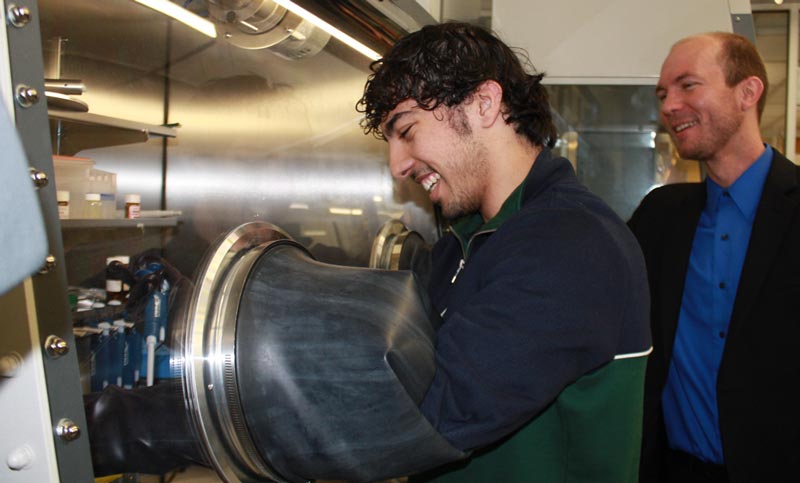Staring into the light
Winter
2012
Building Blocks - Undergraduate Research and Outreach Projects
Staring into the light
New device will measure LED glow
By:Omar Hassan and Roxanne Lee at the University of Texas at Dallas

Organic light-emitting diodes (OLEDs) are much like regular LEDs, such as the green bulb next to the start-up button on any desktop computer or the red bulb that lights up on your remote control. Light in those standard LEDs comes from a piece of semiconductor within the bulb, which gives off energy when a certain voltage is applied to it. An OLED is a special kind of LED with a plastic-like semiconductor made of organic materials. In many cases, organic materials are cheaper to make than traditional semiconductors, and they have the potential to produce more efficient LEDs.
Cell phone displays made by Samsung, Motorola, and Nokia already use OLEDs, and some OLED TVs are currently on the market. OLEDs are desirable for those display applications because of their vivid colors, wide viewing angles, and low power consumptions. OLEDs can also be connected to make flexible displays (imagine an iPad that you can wrap around your wrist). Many hope to replace fluorescent and incandescent lighting with more efficient OLED lighting. But there is still work to be done to improve the efficiency and lifetime of OLEDs. Much more research and testing is needed before they become usable in lighting applications.
That’s where our research advisor at the University of Texas at Dallas, Jason Slinker, comes in. He currently makes OLEDs using various organic materials and tests the lifespan of those OLEDs with an instrument that can only test one LED at a time. Each test can take weeks or even months. In addition, the instrument cannot detect OLED color changes over time, an ability that would be useful in determining the timing of particular chemical reactions within the OLED. Ultimately, what would be useful for our advisor and other researchers is an easily assembled instrument that can measure the light intensity and color of several OLEDs at a time.
With some funding from a 2012 Sigma Pi Sigma Undergraduate Research Award, we are building an instrument designed for this purpose. It contains circuitry designed to control the current through and voltage across any of eight OLEDs. But since the photodiodes used in this kind of testing only sense the intensity of the light, not the spectrum of light coming from the OLEDs, the second part of our project is an experimental instrument design that uses a different light-sensing device. Our idea was to test several different picture-taking devices, such as scanners and cameras, to see if we could get reliable light spectrum data as well as light intensity data comparable to that of the photodiodes (or even more accurate, if possible).
We started out by purchasing a regular color scanner but quickly found it to be unsuitable. It used a three-color LED to excite colors sequentially but a monochrome detector, so it was incapable of measuring the color of our LEDs. We needed a scanner with a color detector and reasoned that older models were better candidates. We found a “broken” scanner from university surplus that actually worked quite well. The light source was not functional—which was perfect, as we only wanted to measure light coming from the LED. So the scanner from the trash was better than the scanner from the store!
The scanner was able to track the light intensity of test LEDs fairly well. However, the color spectra of the LEDs returned by the scanner were variable. Some colors were fine, while other colors were off. We reasoned that the scanner’s light detector or internal processing was correcting the image based on its intended light source—possibly a fluorescent bulb with a highly nonlinear spectrum. This hypothesis gained credibility when we found another scanner of the same model with a functional light source (amazingly, also from the trash) and measured its spectrum to be that of a standard fluorescent light. We have submitted the results for publication.
The scanner takes intensity data over a decent range, and it may be useful for tracking relative changes in color. In the meantime, the first prototype that uses photodiodes for its light-sensing element is nearly complete. This instrument will be used in our advisor’s lab continually after it is completed. Thus, our instrument will have immediate use in the quest to find more efficient light sources, and other LED researchers may follow our design for rapid device testing. //
Receive up to $2,000 for your chapter research project!
Each year Sigma Pi Sigma awards research funding of up to $2,000 to several SPS chapters for research activities. For details, see www.spsnational.org/programs/awards/research.htm.
More from this department
Building Blocks - Undergraduate Research and Outreach Projects
